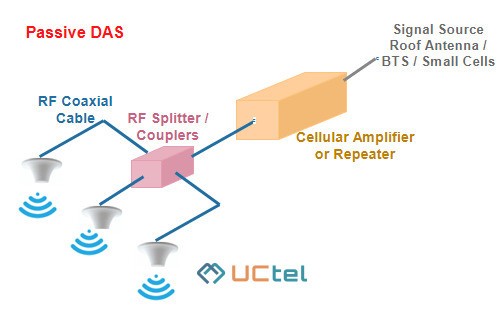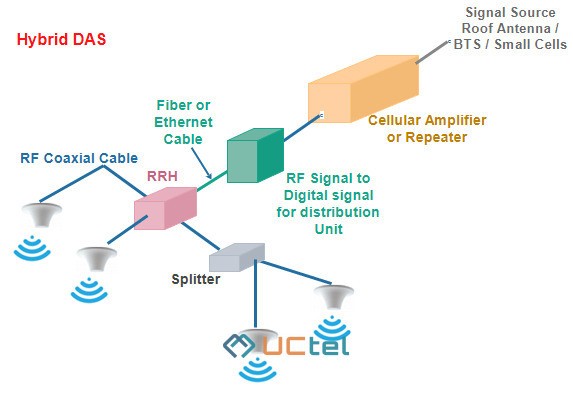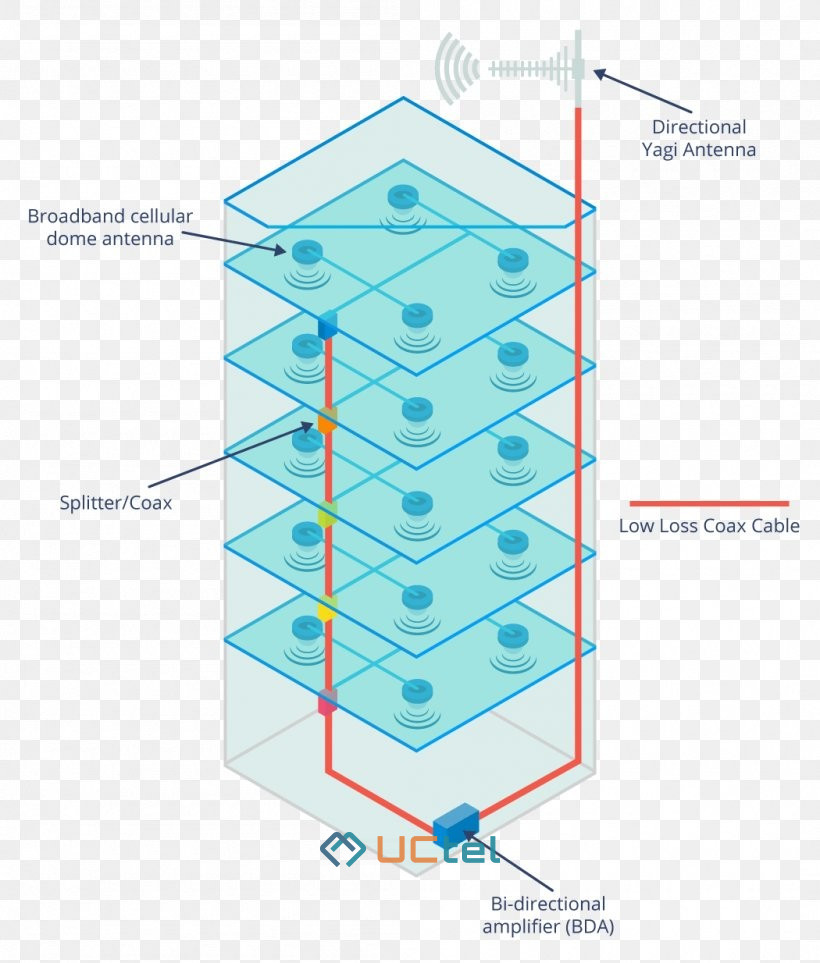
Complete Guide to DAS Solutions: Equipment and Installation
Table of contents
As mobile phones continue to be essential devices in our lives, the issue of mobile signal coverage in buildings and structures is becoming an ever more pressing one. As a result of the BYOD (bring your own device) concept spreading to businesses in the United Kingdom, BYOD occurred in 60% of all finance or insurance companies.
Meanwhile, according to CommScope, only 2% of the world's more than 30 billion m2 of office space is covered by in-building mobile wireless systems. Part of the solution to this problem is DAS (distributed antenna systems), which provide indoor coverage and enable significant business benefits through quality communication. In this article, we’ll consider how these systems work, what businesses need them for, the peculiarities of their installation, and how to choose a reliable DAS solution company to ensure uninterrupted communication.
How do Distributed Antenna Systems Work?
DAS is a convergent unified signal transmission medium connecting spatially separated antennas that provide users with wireless signals within a building. Convergence in this case is the ability to transmit multiple signals, supporting voice and data over a single cable.
There are three types of DAS:
- Passive
- Active
- Hybrid
Passive DAS
This type of DAS solution uses a coaxial cable to transmit the signal throughout the required area, e.g., each floor of a building. The system is based on different types of passive elements such as cables, connectors, and splitters. These elements combine to form the DAS which can distribute the signal over the floors and rooms. There are no active electronic components in passive DAS.

Advantages of passive DAS
- No need for maintenance and adjustment of network components.
- No additional intermodulation noise in the system enables multi-channel operation without any degradation of services due to possible interference.
Disadvantages of passive DAS
- Cost and complexity of laying large diameter coaxial cables.
- Limited coverage area due to attenuation in coaxial cables. An antenna cannot be located a long distance from the signal source.
Active DAS
In this type of distributed antenna system solution, the radio signal at the input is converted into an optical signal. A central control unit or base station is responsible for this. The signal is transmitted via fibre optics to internal active antennas with an integrated remote control unit.

Advantages of active DAS
- Can provide in-building coverage over large areas due to the longer length and zero loss characteristics of fibre optic links.
- Guaranteed signal strength at the input of each antenna, regardless of its distance from the source.
- The ability to remotely monitor and control each individual antenna enables the localisation of possible communication quality problems.
- No interference between antennas.
- Easy scalability and expansion of coverage area and capacity.
- No limit on the number of antennas since each antenna is an extension of only one signal source, there is no need to configure each antenna for a specific installation location.
Disadvantages of active DAS
- More expensive solution.
- Remote units need to be supplied with power.
Hybrid DAS
A combination of active and passive DAS solutions. A hybrid DAS solution uses passive components such as couplers and splitters to connect more than one antenna to a remote access unit. These units are installed on the floors and convert the digital signal to analogue, while a horizontal coaxial cable construction connects the internal antennas.

Advantages of hybrid DAS
- The signal level at each antenna is higher than in passive DAS.
- Cheaper than an active DAS.
- Transmits a strong and stable signal to each remote control unit, irrespective of the remoteness of the signal source.
Disadvantages of hybrid DAS
- Has signal level loss problems at horizontal level (cable structures from the remote control unit to antennas).
- Heavy horizontal level cable system.
- Doesn’t allow for administration of the status of each specific antenna, although the ability to administer remote access units remains.
What Problems Does a Distributed Antenna System Solve?
One of the distinguishing features of DAS systems is the convenient operation in multiple frequency bands simultaneously and the support of different technologies. To put it simply, it allows you to work with several providers simultaneously without any inconvenience.
The most expedient installation of the DAS solutions in the UK is at sites with heavy data traffic and places where uninterrupted communication is crucial. For example, in-building DAS solutions are often used in hospitals, business centres, stadiums, hospitals, and other public and social facilities.
Imagine the load on the network outside a stadium during an important match or in a concert hall during a performance by a world star. Standard equipment simply wouldn’t be able to keep all visitors connected, but with a DAS solution provider, this problem can be easily solved.
In general, the benefits of installing DAS can be summarised as follows:
- Delivering quality services in mobile data networks requires bringing subscribers as close as possible to the sources of data transmission. DAS is ideal for this task because the compact antennas can be placed literally everywhere.
- Another significant advantage of DAS is their technology-neutral nature, i.e., their ability to support different communication protocols using the same relatively inexpensive fibre optic or cable network.
- DAS are virtually maintenance-free and, once installed, require no further configuration.
- DAS allows easy and cost-effective addition of capacity (network scaling), either by connecting new base stations at existing sites or by increasing the coverage area.
- DAS improves spectral efficiency, which reduces interference on neighbouring sectors and channels.
The experience of world-renown companies only confirms the feasibility of installing these solutions. For example, the American company Verizon Wireless has already announced its intention to actively use DAS for improving connectivity and signal gain of stadiums and airports. Let’s look at the distributed antenna system installation process.
In-Building DAS Installation Process and Equipment
DAS installation is a highly individual process. It must be discussed on a case-by-case basis. Its particularities depend heavily on the type of DAS and whether it is installed outdoors or indoors. Nevertheless, each DAS consists of several typical elements:

- The donor antenna
The antenna is placed by DAS installers in a convenient location to catch radio signals from the cell tower. In this case, the higher the better, and hence the optimum location for minimising interference is to mount it on the roof. This kind of antenna is capable of receiving signals on various frequencies, including those from different operators and emergency services.
- Repeater unit
The purpose of a repeater unit is to receive signals from a donor antenna. DAS integrators usually install it in special rooms of the building, e.g., the communications room. The repeater receives the signal, boosts it, and transmits it to the whole building.
- Indoor antennas
These antennas are strategically placed throughout the building. The received signal is redistributed through cables. Due to their small size, the nodes are inconspicuous and do an excellent job of providing a signal in hard-to-reach parts of the building. The exact layout of such nodes can only be determined by a site survey by DAS solution providers.
Although each DAS consists of the above elements, there are differences in components, placement, and cabling. That is why the installation process requires a DAS solution provider’s site survey to determine what is best in each particular case. For the same reason, it is difficult to give an exact cost of the DAS.
How Can We Help?
So now you know what a DAS is, why it’s needed, and what the installation process is like. But where do you find the right DAS solution providers to install it in a timely and efficient manner? In this case, we can recommend the services of the UCtel DAS installation company.
UCtel is a systems integrator and DAS solution company that has been providing leading unified communications and in-building mobile signal solutions to businesses for 11 years. We provide all types of systems, including on-premises, cloud, and hybrid solutions. Working with us ensures seamless communication and a significant competitive advantage.
We work in sectors ranging from healthcare to agriculture, construction, retail, and warehousing. With us, you'll get cutting-edge technology that enables faster communication, more efficient collaboration, and better operations.
But don't take our word for it. Better take a look at our case study.
London North West University Healthcare NHS Trust
So, what have we got? Two hospitals of 46,027 m2 (495,432 sq ft) combined. In both cases, the hospitals had problems with indoor mobile coverage for hospital staff and patients. The issue was particularly acute during the COVID-19 outbreak, when phones were the primary communication channel for many people and staff needed to respond quickly to patients' changing conditions. London North West University approached us for help, and we set about drawing up a list of requirements.
Key requirements for mobile technology included:
- Access to digital patient records on tablets and mobile phones.
- Communication between staff and patients.
- Communication between patients and their relatives.
- Digital scheduling capability for doctors and nurses.
Next, together with our partner Cisilion, we began to select the best solution for the above tasks. Our choice was Cel-Fi QUATRA. However, due to the different sizes and shapes of the hospitals, we had to take different approaches.
For Northwick Park Hospital, three QUATRA systems per network were sufficient to give the necessary coverage across three buildings. The Middlesex Central Hospital was a much larger building, and in this case, a hybrid of QUATRA and passive DAS solution was used.
Ultimately, we provided all buildings with full mobile coverage where it was needed to support doctors and patients. We now continue to work with these institutions and successfully maintain the seamless operation of the solutions.
Final Thoughts
Providing a stable connection involves a lot of organisational and technical complexities. Sometimes the operator base stations are located too far away from the site; their signal penetration is often hindered by the materials used to construct the building. With a high-end DAS solution installation, you can solve all these problems in the snap of a finger, forget about interruptions, and focus on more important things. The main thing here is to have professionals by your side who can install the DAS solution in the UK in a quality and timely manner. And that's exactly what our UCtel DAS solution company offers. Contact us, and we will provide your business with a stable signal and uninterrupted communication.






